

The White House appoints Dr. Penrose (Parney) C. Albright to help develop the founding legislation for the Department and establish the Science and Technology Directorate (S&T). Dr. Albright and a cadre of scientists set up shop at the Transition Planning Office for the Department of Homeland Security at 8th & G Streets in Washington, DC, to stand up S&T with support from the Office of Management & Budget.
The following year, Dr. Albright would be confirmed by the Senate to serve as Assistant Secretary of Homeland Security, a position based at S&T.


The U.S. Department of Homeland Security (DHS), created by integrating 22 federal entities under one umbrella, is officially established on March 1, 2003.
The Science and Technology Directorate (S&T) is established as the research and development arm of the Department of Homeland Security and science advisor to the Secretary. Dr. Charles E. McQueary is named as the first Under Secretary for Science and Technology (USST).
S&T implements the Support Anti-Terrorism by Fostering Effective Technologies (SAFETY) Act of 2002 to encourage the development and rapid deployment of lifesaving, qualified anti-terrorism technologies. With SAFETY Act protections, manufacturers and sellers receive limited liability protections resulting from the use of such technologies during terrorist incidents.
S&T assumes responsibility for the operation of the Plum Island Animal Disease Center (PIADC). Previously part of the Department of Agriculture, PIADC protects the nation’s agriculture against the accidental, natural, or intentional introduction of transboundary animal diseases.
The Program for Response Operations & Technology Enhancements—PROTECT—deployed chemical sensors to Boston and New York City subway systems for the Republican and Democratic National Conventions in 2003 and later transitioned them to local authorities in those cities in addition to deploying the capability to the DC Metro system.
S&T’s first start-to-finish product, the Portable High-Throughput Integrated Laboratory Identification System (PHILIS) is transferred to the Environmental Protection Agency for deployment. PHILIS featured a fleet of vehicles equipped to function as mobile high-tech labs that could be rushed to the scene of a chemical release response.
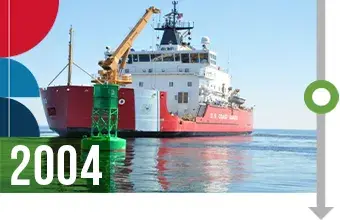

S&T and the National Science Foundation launch the Cyber Defense Technology Experimental Research (DETER) Network, a research project involving multiple universities that created a cybersecurity testbed to safely test and evaluate defensive measures to mitigate against cyberattacks.
S&T establishes the inaugural DHS Center of Excellence: The Center for Risk and Economic Analysis of Terrorism, led by the University of Southern California.
S&T and the U.S. Coast Guard build a testbed to provide immediate coastal surveillance capabilities in southern Florida. Called Hawkeye, the prototype maritime system integrated existing facilities and upgraded equipment to detect, track and identify vessel traffic in the vicinity of ports and test interoperability among DHS and Department of Defense systems and networks.
S&T, DHS, the White House Office of Science and Technology Policy, and the State Department develop and implement an Enhanced International Travel Security System to ensure the authenticity of travel documents and validate the traveler identities.
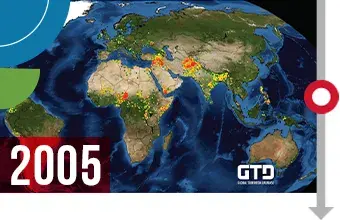

S&T establishes a 5-agency Framework for Coordinated Monitoring of Biological Threats with DHS, Department of Defense, Department of Health and Human Services, Department of Justice, and the U.S. Postal Service to develop concepts of operations and methodologies for environmental and suspicious materials monitoring.
S&T funds the development of the online Global Terrorism Database (GTD), used to study and analyze worldwide terrorist activities. The GTD is the largest terrorist event database, currently including records of more than 200,000 events and attacks that have occurred since 1970.
S&T develops radiation cleanup standards and guidance that was later ratified in regulation during the Obama administration.
Following Hurricane Katrina, S&T provides valuable expertise to guide response efforts. Support includes enhanced emergency responder communications and protective equipment, evacuation logistics, robot-assisted search and rescue, and hazardous biological materials disposal, as well as modeling and simulation analysis of petroleum shortages and disease impacts, critical infrastructure damage, and economic impact.
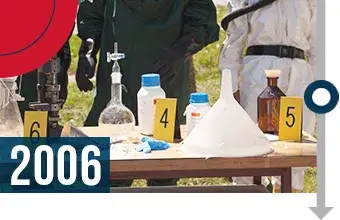

Retired Rear Admiral Jay M. Cohen is confirmed as the second Under Secretary for Science and Technology.
The Chemical Security Analysis Center (CSAC), one of five S&T national laboratories, is established to identify and assess U.S. chemical threats, hazards, and vulnerabilities and provide science-based threat and risk analysis capabilities.
S&T conducts and publishes the first Biological Terrorism Risk Assessment for the National Security Council. The assessment is delivered biennially to better understand the risks and threats that biological terrorism can pose.
S&T delivers enhanced remote sensing and image processing capabilities to FEMA for deeper analysis of catastrophic incidents. Sensors provide critical information on every aspect of response and recovery efforts along the Mississippi Gulf Coast in the months following Hurricane Katrina, including estimating debris volume, evaluating residential structural damage, monitoring environmental conditions, and generating information to integrate into critical map products.
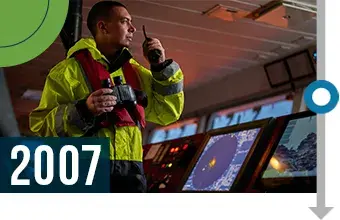

S&T develops the IronKey, a device that provides secure Web browsing, cryptographic authentication, end point security, self-service password recovery, and secure password management.
The first version of the Assistant for Randomized Monitoring Over Routes (ARMOR) is created and deployed at Los Angeles International Airport, resulting in increased seizures of illicit drugs and weapons. The technology was also deployed by the Federal Air Marshal Service and U.S. Coast Guard.
S&T conducts a comprehensive Chemical Threat Risk Assessment for the Homeland Security Council and others to guide prioritization of federal investment in chemical defense-related research, development, planning and preparedness.
S&T transitions SAFECOM to the DHS Office of Emergency Communications. Through SAFECOM, S&T worked with practitioners to enhance public safety communication and interoperability during emergencies and disasters.

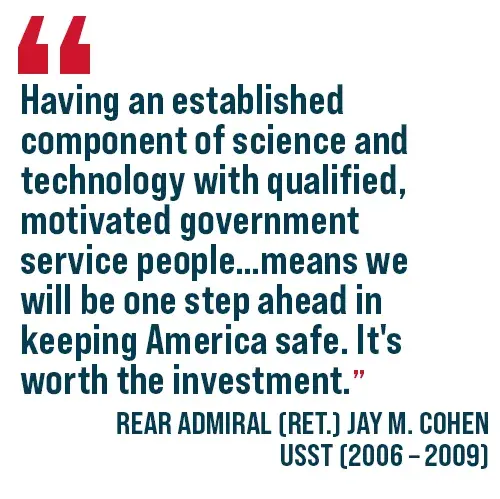
S&T dedicates the National Biodefense Analysis and Countermeasures Center (NBACC), a one-of-a-kind laboratory facility dedicated to defending the nation against biological threats. Its work supports intelligence assessments, preparedness planning, response, emerging threat characterization and bioforensic analyses.
System models prepared by the National Center for Food Protection and Defense identify Mexican jalapenos as the source of a salmonella outbreak. The models saved up to $200 million in avoided produce losses and prevented unnecessary illness and loss of life.
S&T successfully demonstrates the ability to locate underground tunnels from 40 feet with Tunnel Detection, a proof-of-concept capability that uses a small unmanned aerial platform with a radio frequency transmitter and receiver to rapidly screen large geographical areas.
S&T provides the DHS Interagency Modeling and Atmospheric Analysis Center with the capability to receive real-time, high-resolution meteorological data from existing NOAA radars to incorporate these data into more precise aerosol dispersion models—a critical step in assessing the probable path of exposure from a bioattack.
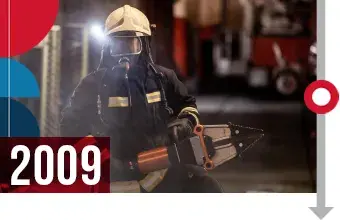

Dr. Tara O’Toole is confirmed as the third Under Secretary for Science and Technology.
S&T establishes the System Assessment and Validation for Emergency Responders (SAVER) program to assist emergency responders in making informed procurement decisions.
S&T develops an innovative, concealable chem/bio escape hood for special operations and delivers over 80 units to U.S. Secret Service for field testing. The one-size-fits-all hood can be donned in 10 seconds, removes toxic industrial chemicals, and filters nerve, blood, and blister agents.
S&T demonstrates capabilities of the Marine Asset Tag Tracking System (MATTS) to federal agencies, Congress, shipping industry companies, and nine international partners. MATTS tracks containers from their port of origin to final destination using a remote global communication and tracking device interfaced with sensors that detect container breaching.
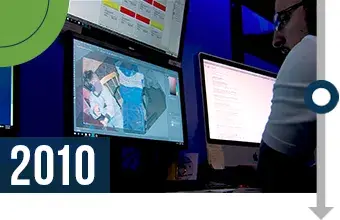

S&T’s Virtual USA (vUSA) information sharing platform was used by Florida, Alabama, and Louisiana emergency management agencies to coordinate response to the Deepwater Horizon Oil Spill, enabling the states to deploy response teams to specific locations, saving time and money, and maximizing the effectiveness of the cleanup effort.
S&T’s Multi-Band Radio, a single, portable radio that operates across the disparate radio bands used by first responders, is commercialized and used to support security efforts at the Kentucky Derby and the Vancouver Olympics.
S&T initiates the groundbreaking DHS Child Exploitation Image Analytics program for U.S. Immigration and Customs Enforcement, which uses a combination of algorithms and forensic image analysis from seized videos, photos, and data to detect and recognize faces for further forensic analysis. The program ultimately results in the identification and rescue of 350 children.


S&T’s Next Generation Incident Command System (NICS) is used during the 2011 Los Angeles Marathon to improve situational awareness and deploy medical personnel for hypothermic at-risk runners and wheelchair participants. CAL FIRE and the Sycuan Band of the Kumeyaay also use NICS during the 2011 firefighting season in San Diego County for response to wildland fires on the Pala and Los Coyotes Reservations.
Following successful commercialization, the Multi-Band Radio is deployed to secure nationwide events including July 4th festivities in Florida, the Chicago Marathon, NASCAR Sprint Cup races in Phoenix, the New Orleans Jazz and Heritage Festival, and Super Bowl XLVI.
Missouri leverages vUSA during the 2011 Mississippi River flooding response to share information related to levee water levels, Civil Air Patrol flood photos, road closures, and hospital status with adjacent jurisdictions.
Based on requirements identified by S&T’s First Responder Resource Group, S&T works with responders and industry partners to create an advanced, disposable EMS backboard cover that drastically reduces potential patient and responder contamination. The backboard cover was designed, tested, and made commercially available in less than eight months.
S&T works with the U.S. Secret Service (USSS) on the Science and Technology for Operational Research Enhancement (STORE) program to rapidly develop and deliver 10 technologies to support USSS protective operations.


S&T develops and patents the first Foot-and-Mouth Disease Vaccine in more than 50 years and obtained conditional licensing to manufacture the vaccine on the U.S. mainland. PIADC and U.S. Department of Agriculture scientists worked for seven years with industry partners, representing a major coup in treating one of the most economically devastating diseases in the world.
S&T’s inflatable tunnel plug prototype is successfully tested in Morgantown, West Virginia. Developed with Pacific Northwest National Laboratory (PNNL), West Virginia University, and ILC Dover, the plug seals off underground subway tunnels from the spread of water during major flooding events.
S&T’s extra high voltage Recovery Transformer (RecX) prototype is piloted with the Electric Power Research Institute. The system connected to the grid and became fully energized and functional in less than six days—compared to the typical two months or more using conventional methods. The prototype remained operational and was named a ‘game changer’ by the American Society of Civil Engineers.
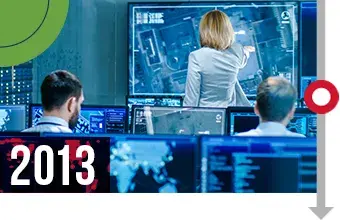
S&T commercializes two vehicle stopping technologies: Pit-BUL™ and NightHawk™. The Pit-Ballistic Undercarriage Lanyard features hidden spikes attached to a net that, when deployed, puncture tires and tangle a car’s axles. The NightHawk is a spike strip disguised as a small suitcase that can be deployed by remote-control for responder safety.
S&T develops a desktop companion to the Chemical Terrorism Risk Assessment and transitions it to the Transportation Security Administration and Department of Health and Human Services. Agencies use the calculator tool to maintain awareness of chemical threats and analyze mitigation and response strategies to protect the public.
The Terrorism and Extremist Database (TEVUS) is heavily used during the Boston Marathon bombing and helps with the post-incident investigation.
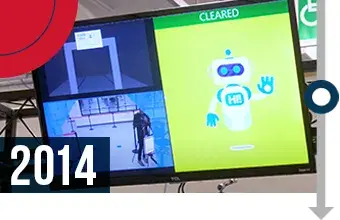

Dr. Reginald Brothers is confirmed as the fourth Under Secretary for Science and Technology.
S&T deploys the Immersive Imaging System, a high-resolution, 360-degree camera to the Boston Marathon in support of Boston Police Department security efforts. S&T continues to refine the technology to improve operator performance and meet emerging requirements, including video analytics at scale. It is currently being operationally piloted at a U.S. professional sports stadium.
S&T and Customs and Border Protection cut the ribbon on the Maryland Test Facility (MdTF), a controlled, reconfigurable environment for comparing and contrasting technologies, observing and documenting human-device interactions, and measuring operational processes. MdTF would soon become the site for S&T’s Biometric Technology Rallies.
S&T joins forces with 14 international counterparts to launch the International Forum to Advance First Responder Innovation (IFAFRI). IFAFRI gives S&T a voice in encouraging the global market to develop affordable solutions for first responders, to work with the response community to define common capability gaps, and to collaborate on R&D to make first responders worldwide safer, more effective, and more efficient at their jobs.
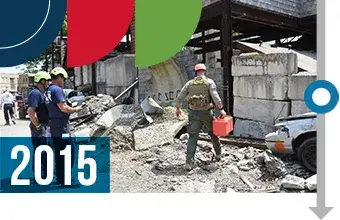

Finding Individuals for Disaster and Emergency Response (FINDER), a radar-based search and rescue technology developed and tested by S&T and the NASA Jet Propulsion Laboratory, is commercialized. Just days after the announcement, rescuers use FINDER to save four lives following a devastating 7.8 magnitude earthquake in Nepal.
S&T launches the DHS Silicon Valley Office (currently the Silicon Valley Innovation Program, or SVIP) to engage with entrepreneurs and innovators and harness the power of the private sector in new ways to address the nation’s pressing homeland security needs. The program continues to reshape how government, entrepreneurs, and industry work together to identify cutting-edge technology solutions.
S&T stands up a new modeling and simulation lab that performs predictive crowd dynamics modeling to inform planning for the papal visit to Washington, DC. The modeling helps identify potential chokepoints and evacuation routes for strategic positioning of security personnel and resources. It also informed local mass transportation planning.
After two years of development and field testing, S&T’s Improved Structure Firefighter Glove receives NFPA Certification and is commercially available for use. The glove allows better fit, dexterity and flexibility while still meeting the heat, water, and puncture resistance criteria required by first responders.
S&T’s National Urban Security Technology Laboratory (NUSTL) conducts the first Urban Operational Experimentation (OpEx) in New York City. The weeklong event allows first responders to test cutting-edge response technologies in realistic urban operational scenarios and provide critical feedback directly to the developers.
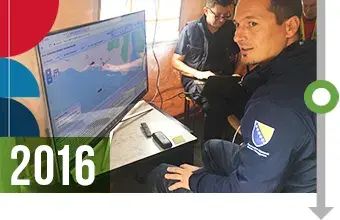

The NICS first responder information sharing tool is transitioned and implemented in NATO member and partner countries as part of NATO’s Science for Peace and Security Project Advanced Regional Civil Emergency Coordination Pilot. The technology helps enhance the efficiency and effectiveness of worldwide humanitarian assistance and disaster relief.
The FBI Hazardous Devices School becomes a testbed for S&T’s Response and Defeat Operations Support (REDOPS) program. The testbed identifies new and emerging technologies and methodologies for public safety bomb squads, assesses capabilities to enhance safe operations, and provides a vehicle to disseminate best practices to bomb technicians nationwide.
Two S&T-funded technologies, Power Hawk and Wireless Emergency Alerts (WEA), are successfully deployed in response to bomb threats in New York and New Jersey. The New Jersey State Police Bomb Squad uses Power Hawk to safely disarm two pipe bombs, while the WEA alert facilitates the identification and subsequent arrest of the bombing suspect.
Using S&T’s Electronic Recovery and Access to Data Prepaid Card Reader, law enforcement officials successfully seized or recovered suspicious cards loaded with approximately $10 million in fraudulent funds. The small, handheld device allows officers to identify and check the card balances and place a temporary hold on linked funds until a full investigation can be completed.
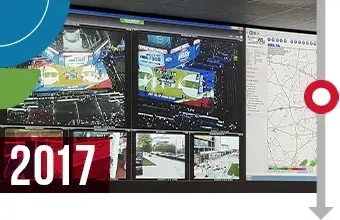

S&T transitions the Smoke and Particulate Resistant Turnout Ensemble (now RedZone™), a suite of personal protective equipment that provides additional protection for firefighters against exposure to carcinogenic vapors and particulate matter at incident sites.
S&T announces the launch of a new partnership to enhance smart cities and apply cutting-edge Internet of Things technologies to first responders and the commercial marketplace. The Smart City Internet of Things Innovation (SCITI) Labs effort is still underway, focusing on applying new and existing technologies to public safety and national security needs and emphasizing extensive validation and go-to-market support through industry partners.
S&T transitions the HURREVAC-eXtended (HV-X) platform to FEMA. HV-X integrates forecast and planning data to provide emergency managers with decision support tools in advance of and during tropical weather. The platform has since been used to inform annual hurricane season planning and response efforts, including during Hurricane Harvey.
S&T’s Datacasting technology is deployed to Super Bowl LI, the NCAA Final Four, and during Hurricane Harvey in Houston. Datacasting allows users to quickly and securely share videos, images, maps, text, and other files to improve situational awareness and streamline cross-agency coordination.
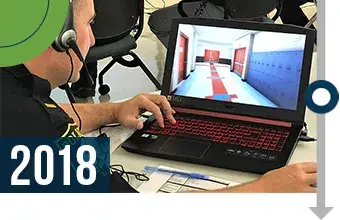

S&T approves the 1,000th SAFETY Act Qualified Anti-Terrorism Technology.
S&T releases a new, free Enhanced Dynamic Geo-Social Environment (EDGE) virtual training platform that allows teachers, school staff, law enforcement officers, and others tasked with school security to create and collaboratively practice response plans for a wide range of critical incidents.
NATO adopts a suite of response robot test methods developed by S&T, the National Institute of Standards and Technology, and ASTM International. The test methods, also adopted by the global bomb squad community and used in subsequent response efforts, enable users to objectively measure and compare robotic capabilities and operator proficiency. They informed expenditures of approximately $70 million in federal, state, local and international robot procurements.
S&T transitions the Reverse Velocity Jet Tamper (ReVJeT) to all U.S. public safety bomb squads. The counter-improvised explosive device tool has a more precise and concentrated propellant stream that disrupts explosives to keep them from detonating and causing harm or damage. ReVJeT improves upon existing platforms by a conservative 300%.
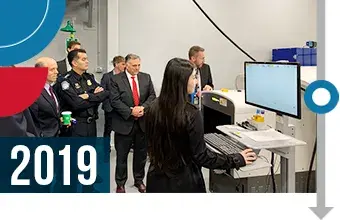
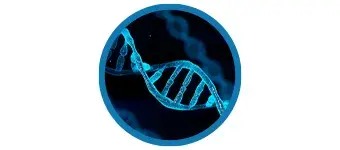
S&T announces both the launch of the $1.55 million Opioid Detection Challenge—a multi-agency effort to develop rapid, nonintrusive detection tools that track illicit opioids being trafficked into the U.S. through international mail—and the prize-winning technologies.
S&T’s groundbreaking Rapid DNA technology is used in the aftermath of the Camp Fire wildfire in Paradise, California, and the Conception boat fire off the coast of Santa Cruz Island, California, to help agencies identify victims of the mass casualty events.
The DHS Small Business Innovation Research program awards its 1,000th contract, signifying the Department’s commitment to and investment in the nation’s small businesses and innovators. Under S&T’s leadership, the program has invested more than $380 million to-date to foster economic growth while addressing homeland security technology needs.
S&T’s Team Awareness Kit (TAK) technology was used by the Coast Guard to rescue 46 ice fishermen on Lake Erie. The mobile TAK app allows agencies to securely exchange data, take and disseminate photos and video, map personnel deployment, and improve overall real-time situational awareness to inform tactical decisions. TAK has also been used to support response to Hurricanes Harvey, Irma, and Dorian, secure Super Bowls, and strengthen border security.


S&T supports the Department’s—and the nation’s—pandemic response, developing research-based, mission-driven tools for decision makers and frontline workers. S&T releases and continues to update the COVID-19 Master Question List (MQL), curates resources for first responders, develops interactive online virus survivability calculators, and publishes scientific studies that continually shape how the virus is categorized.
S&T releases the Resilient Positioning, Navigation, and Timing (PNT) Conformance Framework, used to inform the design and adoption of PNT systems and to help our nation’s critical infrastructure become more resilient to disruptions like GPS jamming and spoofing.
S&T launches Hacking for Homeland Security, an entrepreneurship program that engages students from leading universities to develop innovative solutions to mission-critical homeland security challenges. Undergraduate and graduate student teams work closely with DHS, business mentors, and trained faculty in a semester-long course, applying an entrepreneurial approach to their project-based courses.
S&T transitions next-generation explosives trace detection (ETD) technology to DARPA. The mass spectrometry ETD technology’s initial use case was for security operations, including aviation checkpoints and border crossings, but the program team soon realized it could easily be modified to keep warfighters and the nation safe from weapons of mass destruction threats.


S&T successfully field-tested prototype technologies for early detection of wildfires. The effort by S&T’s Smart Cities Internet of Things Innovation Labs, in partnership with the California Department of Forestry and Fire Protection and The Nature Conservancy, as well as the California Governor’s Office of Emergency Services and the U.S. Fire Administration, will arm response agencies with sensor technology that will significantly reduce the time it takes from detection to response.
S&T publishes groundbreaking COVID-19 environmental studies that demonstrate the effects of heat, humidity, and sunlight on SARS-CoV-2, the virus that causes COVID-19. S&T also joins a multiagency wastewater-based epidemiology coalition to gather virus data from sewer systems and standardize the science to better understand and contain community spread.
S&T develops and releases new Master Question Lists for African Swine Fever and Synthetic Opioids. Like the COVID-19 MQL released in 2020, these documents summarize what is known about both issues so experts can quickly find knowledge gaps and identify solutions.
Two award-winning, next-generation checkpoint screening technologies are licensed for commercialization—the Shoe Scanner and the High Definition-Advanced Imaging System. The two represent significant S&T investments in aviation security, enhancing the passenger screening process and reducing false alarms.
S&T, MIT Lincoln Laboratory, and NYC transit and emergency response partners begin an air sampling study that will impact how urban areas prepare for and recover from chemical or biological incidents. Results will help refine and verify airflow and dispersion models to inform response protocols and protect citizens and critical infrastructure. Related studies also help to determine the most effective measures to reduce the spread of viruses, including COVID-19, on public transit.
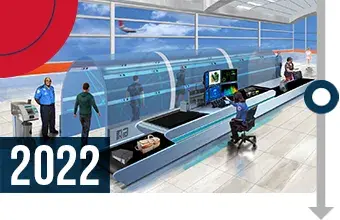
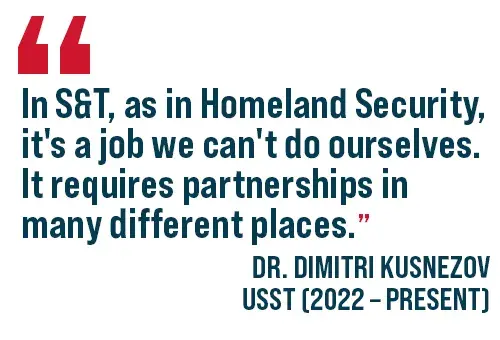
Dr. Dimitri Kusnezov is confirmed as the fifth Under Secretary for Science and Technology.
Technologies developed by S&T and Homeland Security Investigations lead to the arrest of traffickers and several children rescued in the Philippines. The tools and algorithms allow agents to streamline investigations, aggregate huge amounts of data, and build cohesive cases.
S&T and the U.S. Army partner to open the new, experimental Chemical Security Laboratory at Aberdeen Proving Ground. The facility will help CSAC and military experts take a holistic approach to validating scientific data and produce findings that are essential to national readiness.
S&T transitions an advanced, compact carry-on baggage screening system to the Transportation Security Administration. The Reduced Form Factor-Computed Tomography system, developed via S&T’s Screening at Speed Program, delivers the benefits of CT to smaller, regional airports that may not be able to fit conventional scanning systems.
S&T launches the sweeping Critical Infrastructure Security and Resilience Research program, leveraging $157.5 million in funding from the Infrastructure Investment and Jobs Act. Related research, development, testing, and evaluation efforts will take a whole-of-government approach to address key critical infrastructure needs in five targeted strategic mission areas.
Photos for 2006, 2008, 2009, 2010, 2011, 2012 (circle), 2014, 2015, 2015 (circle), 2016, 2017, 2018, 2018 (circle), 2019, 2021, 2021 (circle), 2022: Credit: Science and Technology Directorate; Photo for 2005: Credit Global Terrorism Database, https://www.start.umd.edu/gtd/; Photos for 2002, 2003, 2004, 2005 (circle), 2007, 2007 (circle), 2009 (circle), 2012, 2013, 2017 (circle), 2019 (circle), 2020, 2020 (circle): Credit: iStock.com.
